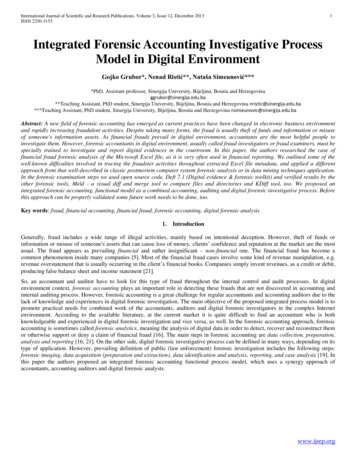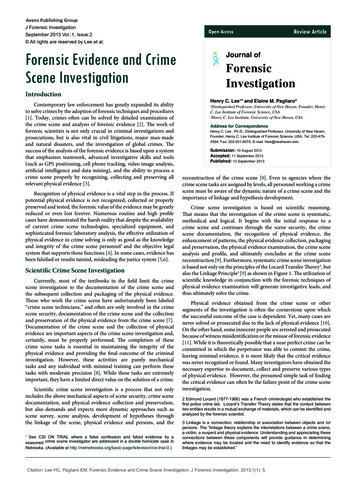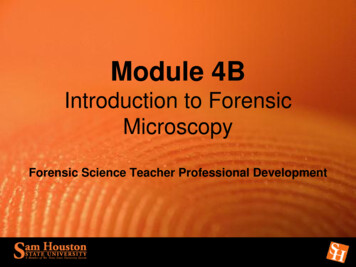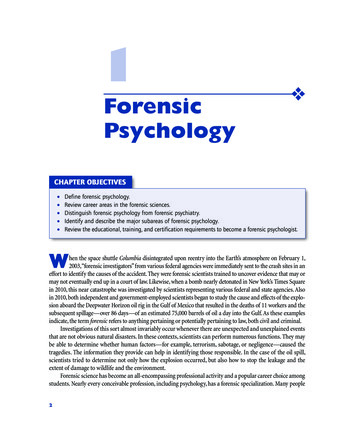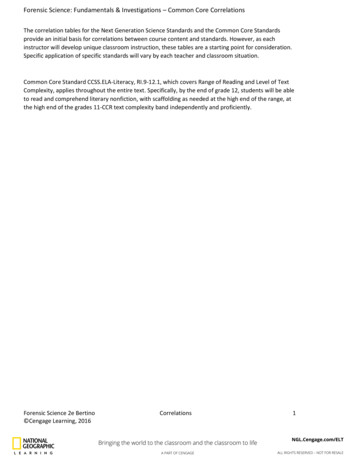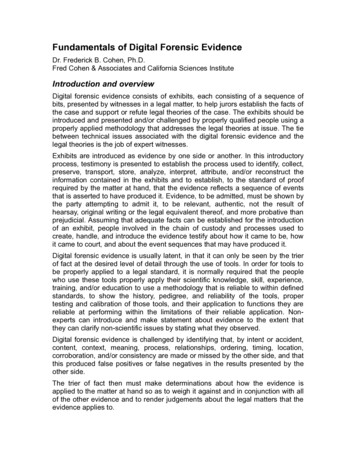
Transcription
Fundamentals of Digital Forensic EvidenceDr. Frederick B. Cohen, Ph.D.Fred Cohen & Associates and California Sciences InstituteIntroduction and overviewDigital forensic evidence consists of exhibits, each consisting of a sequence ofbits, presented by witnesses in a legal matter, to help jurors establish the facts ofthe case and support or refute legal theories of the case. The exhibits should beintroduced and presented and/or challenged by properly qualified people using aproperly applied methodology that addresses the legal theories at issue. The tiebetween technical issues associated with the digital forensic evidence and thelegal theories is the job of expert witnesses.Exhibits are introduced as evidence by one side or another. In this introductoryprocess, testimony is presented to establish the process used to identify, collect,preserve, transport, store, analyze, interpret, attribute, and/or reconstruct theinformation contained in the exhibits and to establish, to the standard of proofrequired by the matter at hand, that the evidence reflects a sequence of eventsthat is asserted to have produced it. Evidence, to be admitted, must be shown bythe party attempting to admit it, to be relevant, authentic, not the result ofhearsay, original writing or the legal equivalent thereof, and more probative thanprejudicial. Assuming that adequate facts can be established for the introductionof an exhibit, people involved in the chain of custody and processes used tocreate, handle, and introduce the evidence testify about how it came to be, howit came to court, and about the event sequences that may have produced it.Digital forensic evidence is usually latent, in that it can only be seen by the trierof fact at the desired level of detail through the use of tools. In order for tools tobe properly applied to a legal standard, it is normally required that the peoplewho use these tools properly apply their scientific knowledge, skill, experience,training, and/or education to use a methodology that is reliable to within definedstandards, to show the history, pedigree, and reliability of the tools, propertesting and calibration of those tools, and their application to functions they arereliable at performing within the limitations of their reliable application. Nonexperts can introduce and make statement about evidence to the extent thatthey can clarify non-scientific issues by stating what they observed.Digital forensic evidence is challenged by identifying that, by intent or accident,content, context, meaning, process, relationships, ordering, timing, location,corroboration, and/or consistency are made or missed by the other side, and thatthis produced false positives or false negatives in the results presented by theother side.The trier of fact then must make determinations about how the evidence isapplied to the matter at hand so as to weigh it against and in conjunction with allof the other evidence and to render judgements about the legal matters that theevidence applies to.
The legal contextDigital forensic evidenceis and must be consideredin light of the legal contextof the matter at hand. This context includes, without limit: The legal matter determines the jurisdictions involved and thus theapplicable laws and legal processes, the legal theories, methodologies,and applications of those methodologies that will be accepted, therequirements for admissibility of evidence, the requirements foracceptance of expert witnesses, the standards of proof, and many othersimilar things that impact the digital forensic evidence and its use. The nature of the case, whether it is civil or criminal, and sub-distinctionswithin these broad categories, affects the standards of proof andadmissibly, the rules of evidence, the rules for trials, and many otheraspects of what can and cannot be used in the legal matter and supportedor refuted through digital forensic evidence. Limitations on elements of the case such as searches and seizures, whichmay be real-time or after the fact, compulsory or permission, and limited invarious ways so as to prevent them from becoming "fishing expeditions"are informed by and help to form the context within which the digitalforensic examiner must operate. Procedural requirements of legal cases may constrain certain argumentsand evidence so that it can only be used at particular times or in particulartypes of hearings. The calendar is often daunting in legal matters, and in many cases thereis very little time to do the things that have to be done with regard todigital forensic evidence. The calendar of the case may also impact thesequence in which evidence is dealt with, and this may result in additionalcomplexities relating to the ordering of activities undertaken. Cost is an important factor because only finite available financial resourceis available. While there may be an enormous range of analysis that couldbe undertaken, much of it may not be undertaken because of costconstraints. Strategies and tactics of the case may limit the approaches that may betaken to the digital forensic evidence. For example, even though somesorts of analysis may be feasible, they may be potentially harmful to theside of the case the forensic examiner is involved in, and therefore notundertaken by that side. Availability of witnesses and evidence is often limited. In some casesevidence may only be examined in a specific location and under specificsupervision, while in most cases, witnesses are only available to theattorneys during limited time frames and under limited circumstances. For
the opposition to the party bringing the witness, these may be very limitedand restricted to testimony under oath in depositions and elsewhere. Stipulations often limit the utility and applicability of digital forensicevidence. For example, if there is a stipulation as to a factual matter, evenif the digital forensic evidence would seem to refute that stipulation, it canbe given no weight because the stipulation is, legally speaking, a fact thatis agreed to by all parties and therefore cannot be refuted. Prior statements of witnesses often create situations in which digitalforensic evidence is applied to confirm or refute those statements. Inthese cases, the goal is to find evidence that would tend to refute thestatements and thereby make the witness and their prior testimonyincredible.Notes and other related materials are potentially subject to subpoena inlegal matters, and therefore, conjectures on notes, FAXes, and drafts ofexpert reports as well as other similar material might be discoverable andused to refute the work of the experts. This tends to limit the manner inwhich the expert can workwithout endangering the Figure 1 – The wayfloppy disks encodecase for their client.digital signalsThere are many other similar(from [2])legal contextual issues that drivethe digital forensics process andDigitalforensicthe work of those who undertakeevidence consists of digital "bits", each ofthose processes. And withoutwhich is a '1' or a '0'; however, that evidencethis context, it is very difficult ifis realized in the physical world by physicalnot impossible to do the jobmechanisms that, generally speaking, areproperly. While it is the task ofnot themselves digital. In some cases, thethe lawyers to limit the efforts ofmechanisms by which the evidence wasthe digital forensics evidenceproduced become part of the issue that mustworkers in these regards, it is thebe addressed.task of the workers to know whatthey are doing and how to do itproperly within the legal context. Those who engage in work related to digital forensic evidence must understandthese issues at a rudimentary level in order to be useful to the legal process, andthey must understand these issues and be willing to work within the context ofthe legal system and the specifics of the matter at hand in order to work in thisarea.The processes involved with digital forensic evidenceWhile there are many other characterizations of the processes involved indealing with digital forensic evidence (DFE), the perspective taken here willassume, without limit, the DFE must be identified, collected, preserved,transported, stored, analyzed, interpreted, attributed, perhaps reconstructed,
presented, and, depending on court orders, destroyed. [1] All of these must bedone in a manner that meets the legal standards of the jurisdiction and the PresentDestroyIn order to be processed and applied, evidence must first,somehow, be identified as evidence. It is common for there tobe an enormous amount of potential evidence available for alegal matter, and for the vast majority of the potential evidenceto never be identified. To get a sense of this, consider thatevery sequence of events within a single computer mightcause interactions with files and the file systems in which theyreside, other processes and the programs they are executingand the files they produce and manage, and log files and audittrails of various sorts. In a networked environment, thisextends to all networked devices, potentially all over the world. Evidence of anactivity that caused digital forensic evidence to come into being might becontained in a time stamp associated with a different program in a differentcomputer on the other side of the world that was offset from its usual pattern ofbehavior by a few microseconds. If the evidence cannot be identified as relevantevidence, it may never be collected or processed at all, and it may not evencontinue to exist in digital form by the time it is discovered to have relevance.CollectionIn order to be considered for use in court, identified evidence must be collectedin such a manner as to preserve its integrity throughout the process, includingthe preservation of information related to the chain of custody under which it wascollected and preserved. Recent case law has established that there is a duty topreserve digital forensic evidence once the holder of that evidence is orreasonably should be aware that it has potential value in a legal matter. This dutyis typically fulfilled by collecting and preserving a copy of the original evidence sothat the actual original media need not be preserved, but rather, can continue tobe used. Collection may involve many different technologies and techniquesdepending on the circumstance.What is collected is driven by what is identified; however, a common practice inthe digital forensics community has been to take forensically sound images of allbits contained within each media containing identified content. This provides themeans to then identify further evidence contained within that media forsubsequent analysis, assuming that the copy of the media was properlypreserved along the way. The problem with this process today is that the volumeof storage required has become very large in many cases, and this processtends to be highly disruptive of operating businesses that use these computers ina non-stop fashion. Consider the business impact on an Internet ServiceProvider if they have to cease operations of a computer that would otherwise bein use in order to preserve evidence.
Preservation of relevant log filesand audit data is particularly Many cases have hinged on log, audit, andimportant and should always be other related data, if only to show that theidentified and preserved. This other digital forensic evidence is real. Andincludes all logs associated with case after case today is being lost becausethe servers used to send, of inadequate records retention andreceive, process, and store the disposition policies and processes. Almostevidence. Failure to do this any case demands that evidence bebecomes particularly problematic properly identified and preserved, and thatin cases when the purity of the includes meta-data and log data, bothevidence is at issue. For locally and from independent third partyexample, if an exhibit contains sources who have no interest in the matter.some corrupt content, the entireexhibit becomes suspect. If original records are not available to rehabilitaterelevant portions of the exhibit, all of the evidence contained in the exhibit maybe inadmissible. If there is suspicion of spoliation, the additional log files andrelated records will be necessary in order to show that redundant informationexists that is consistent with the actual creation of the content at issue. Eveninformation such as system crashes and reboots may be critical to a casebecause corrupt file content may be produced by those sorts of events andwithout the logs to show what happened when, that corruption may not be ableto be reconciled with the need for preservation of the purity of the evidence.TransportationEvidence must sometimes be transported from place to place. For example,when collected from a crime scene, the evidence must somehow be moved to asecure location or it may not be properly preserved through to a trial. Digitalforensic evidence can generally be transported by making exact duplicates, atthe level of bits, of the original content. This includes, without limit, the movementof the content over networks, assuming adequate precautions are taken toassure its purity during that transportation. Evidence is often copied and sentelectronically, on compact disks, or in other media, from place to place. Originalcopies are normally kept in a secure location in order to act as the originalevidence that is introduced into the legal proceedings. If there is any questionabout the bits contained in the evidence, it can be settled by returning to theoriginal. Facsimile evidence, printouts, and other similar depictions of digitalforensic evidence may also be transported, but they are not a good substitute forthe original digital forensic evidence in most cases, among other reasons,because they make it far harder, if not impossible, to properly analyze what theoriginal bits were. For example, many different bit sequences may produce theoutput depictions, and identical bit sequences may produce different outputdepictions. Care must be taken in transportation to prevent spoliation as well. Forexample, in a hot car, digital media tends to lose bits.Increasingly evidence is transported electronically from place to place, and eventhe simplest errors can cause the data arriving to be incorrect or improperlyauthenticated for legal purposes. Care must be taken to preserve chain of
custody and assure that a witness can testify accurately about what took place,using and retaining contemporary notes, and taking proper precautions to assurethat evidence is not spoliated and is properly treated along the way. [1]StorageIn storage, digital media must be properly maintained for the period of timerequired for the purposes of trial. Depending on the particular media, this mayinvolve any number of requirements ranging from temperature and humiditycontrols to the need to supply additional power, or to reread media. Storage mustbe adequately secure to assure proper chain of custody, and typically, forevidence areas containing large volumes of evidence, paperwork associated withall actions related to the evidence must be kept to assure that evidence doesn'tgo anywhere without being properly traced. Many different sorts of things can gowrong in storage, including, without limit, decay over time, environmentalchanges resulting in the presence or absence of a necessary condition forpreservation, direct environmental assault on the media, fires, floods, and otherexternal events reaching the evidence, loss of power to batteries and othermedia-preserving mechanisms, and decay over time from other natural andartificial sources.Analysis, interpretation, and attributionAnalysis, interpretation, and attribution of evidence are the most difficult aspectsencountered by most forensic analysts. In the digital forensics arena, there areusually only a finite number of possible event sequences that could haveproduced evidence; however, the actual number of possible sequences may bealmost unfathomably large. In essence, almost any execution of an instruction bythe computing environment containing or generating the evidence may have animpact on the evidence.Since it is infeasible to reconstruct every possible sequence to find all of thesequences that may have produced the actual evidence in a any particular case,analysts focus in on large sets of sequences of events and tend to characterizethings in those terms. For example, if the evidence includes a log file thatappears to be associated with a file transfer, the name of the file transferprogram included in the log file will typically be associated with common behaviorof that program and used as a basis for the analysis. The user identity indicatedin the log file may be associated with a human or group, and this creates aninitial attribution that can then be used as a basis for further efforts to attribute tothe standard of proof required.Of course the presence of this record in an audit trail doesn't mean that theprogram was ever run at all or that the thing the record indicates ever took placeor that the user identified caused the events of interest. There are many possiblesequences of events that could result in the presence of such a record. Forexample, and without limiting the totality of possible event sequences, the recordcould have been placed there maliciously, it could be a record produced byanother program that looks similar to the program being considered, it could
have been a record produced by the program even though the file transfer failed,the record could have been produced by a Trojan horse acting for the user, orthe record could be there because of a failure in a disk write that produced across-link between disk blocks associated with different sorts of records.The analyst seeking to interpret the evidence should seek to take into accountthe alternative explanations for evidence in trying to understand what actuallytook place and how certain they are of the assertions they make. It is fairlycommon for supposed experts to make leaps and draw conclusions that are notjustified. For example, an analyst might write a report stating something like "Xdid Y producing Z" where X is an individual or program and Y is an action thatproduced some element of the evidence Z. But this is excessive in almost allcases. A more appropriate conclusion might be "Based on the evidence availableto me at this time, it appears that X did Y producing Z". And of course it helps ifsome or many of the alternative explanations have been explored and shown tobe inconsistent with the evidence. That's one of the reasons that seeminglyirrelevant evidence might be very useful in a legal matter. For example, evidencefrom system logs might indicate that there were no detected disk errors, systemcrashes or reboots, or other anomalies reflected in the log files for the period inquestion, and that therefore, the explanations associated with these sorts ofanomalies are inconsistent with the evidence. But without those log files or someother evidence, this conclusion cannot be reasonably drawn.In networked environments, there are potentially far more sequences of bits thatmay be relevant to the issues in the matter at hand. As a result, there ispotentially far more evidence available, and the analysis and interpretation ofthat larger body of evidence leads to many more potential analytical andinterpretive processes and products. It could be argued that this increases thecomplexity of analysis exponentially, but in reality, the additional evidence tendsto further restrict the number of histories that are feasible in order to retainconsistency of interoperation across the evidence. As an example, the filetransfer record identified above might be greatly bolstered or flatly refuted bycorresponding records on remote systems from which the file was asserted to bedownloaded and through which the transfer may have come.Analysis, interpretation, and attribution of digital forensic evidence are alsoreconcilable with non-digital evidence and externally stipulated or demonstratedfacts. As an example, if the digital forensic evidence appears to show thatperson X was present at the local console of a computer in Los Angeles,California two hours after they passed through customs and immigration inLondon, England, even though the network logs from distant systems show thatthe transfer took place, it is not a reasonable interpretation to assert that theindividual was in Los Angeles. Clearly there is another explanation, whether it istwo individuals, a remote control mechanism, alteration of multiple logs inmultiple systems, alteration of customs and immigration logs, altered time clocks,or any of a long list of other possibilities. While in some venues, the "don'tconfuse me with the facts" approach may apply, in a legal setting, digital forensicevidence should reconcile with external reality.
Anchor facts that the analyst can testify to are a good example of the interactionbetween digital forensic evidence and physical reality. An example of an anchorfact is knowledge of time keeping mechanisms on systems that interact withevidence available in the matter at hand. For example, if the analyst operates asystem that retains sound records and was synchronized to network timeprotocol during the period of time at issue, and that system has a record of anemail passing through a relevant system that includes time and date stamps,then the time skew between the analysts system and the relevant systemprovides an anchor in facts that the analyst can use to make more definitivestatements about what took place and when. Interpretation of the evidence canthen more definitively assert that, based on the personal knowledge of thewitness and the records they have of facts relevant to the matter, a particularrecord is consistent with a time skew of 18 hours. This may even allow theanalyst to explain how the individual could have appeared to have been inLondon at the same time they appeared to have been in Los Angeles.ReconstructionIn many cases, the relevance of the evidence is specific to hardware and/orsoftware. While many analysts make the assumption that mechanisms operateaccording to their specifications, in the information technology arena, wheredigital forensic evidence originates, there are in fact few standards and they areliberally violated all of the time. Documentation is often at odds with reality,versions of systems and software change at a high rate, and records of whatwas in place at any given time are often scarce to non-existent. Legal cases alsooften come to trial many years after the actual events that led to them take place,and evidence that might have been present at the time of the incident at issuemay no longer be available by the time is is known to be of import.In these cases, reconstruction of the mechanisms that produced the records ofimport may be the only available approach to resolving, to a reasonable level ofcertainty, what actually could and could not have taken place. For example, if thecontent of the metadata within a document containing evidence of intentindicates that a particular user identity modified the document on a particulardate and at a particular time and that the document was edited for 7 minutes and23 seconds, but does not show specific modifications made by that individual,and a previous version of the document from an hour earlier written with anotheruser identity does not have the content with the evidence of intent and has anedit time of 5 minutes, and no other documentation exists, then it might appearto be strong evidence that the individual who last wrote the document added thecontent indicative of intent and did so by editing the document for 2 minutes and23 seconds.But this conclusion depends on a set of assumptions surrounding the software inuse for editing this document. Even if a current version of this software reliablyapplies this sorts of metadata, it may be that the version of software in use at thetime in question and in the computing environments in question did somethingquite different. If this is the only evidence of the issue at hand, and the matter is
important enough to justify the effort, then a reconstruction of the process bywhich the digital forensic evidence was created may be necessary to show thatthe specific version of the software operating in the specific environment at issuecould or could not have produced the results contained in the evidence and thatother possibilities do or do not exist.Given that a reconstruction is to be considered, additional determinations mustbe made. For example, based on the available information, how can a definitivedetermination be made about the version of the hardware, software, andoperating environment be made, and how important is it to precisely reconstructthe original situation down to what level of accuracy and in what aspects? Theanswer to these and other related questions are tied intimately to the details atissue in the matter at hand.PresentationEvidence, analysis, interpretation, and attribution, must ultimately be presentedin the form of expert reports, depositions, and testimony. The presentation ofevidence and its analysis, interpretation, and attribution have many challenges,but presentation is only addressed to a limited extent in the literature. [1]Presentation is more of an art than a science, but there is a substantial amountof scientific literature on methods of presentation and their impact on those whoobserve those presentations. Aspects ranging from the order of presentation ofinformation to the use of graphics and demonstrations all present significantchallenges and are poorly defined.DestructionCourts often order evidence and other information associated with a legal matterto be destroyed or returned after its use in the matter ends. This applies to tradesecrets, confidential patent and client-related information, copyrighted works,and information that enterprises normally dispose of but must retain for theduration of the legal process. Data retention and disposition has extensiveliterature involving legal restrictions on and mandates for destruction. [9]There are also significant technical issues associated with destruction of digitaldata. The processes for destruction in legal matters rarely rise to the levelrequired for national security issues; however, the efforts involved in evidencerecovery do, at times, go the extremes. [10][11][14]Expert witnessesThe US Federal Rules of Evidence (FRE) [3] and the rulings in the Daubert case[4] express the most commonly applied standards with respect to issues ofexpert witnesses and will be used as a basis for this discussion (FRE Rules 701706). Digital forensic evidence is normally introduced by expert witnesses exceptin cases where non-experts can bring clarity to non-scientific issues by statingwhat they observed or did. For example, a non-expert who works at a companymay introduce the data they extracted from a company database and discuss
how the database works and how it is normally used from a nontechnical standpoint. To the extent that the witness is thecustodian of the system or its content, they can testify to mattersrelated to that custodial role as well.Only expert witnesses can address issues based on scientific,technical, or other specialized knowledge. A witness qualified asan expert by knowledge, skill, experience, training, or education,may testify in the form of an opinion or otherwise, if (1) thetestimony is based on sufficient facts or data, (2) the testimony isthe product of reliable principles and methods, and (3) the witnesshas applied the principles and methods reliably to the facts of thecase. If facts are reasonably relied upon by experts in forming opinions orinferences, the facts need not be admissible for the opinion or inference to beadmitted; however, the expert may in any event be required to disclose theunderlying facts or data on cross-examination. [3](FRE Rules 701-706) assummarized in [1] (pp 127-8)Experts typically have very specialized knowledge about specific things of importto the matter at hand. and anyone put up as an expert that doesn't have therequisite specialized knowledge is subject to being seriously challenged bycompetent experts and counsel on the other side. Experts who are shown to beinadequate to the task are sometimes chastised in the formal decisions made bythe courts, and such witnesses are often unable to work in the field for a periodof many years thereafter because counsel for the opposition will bring this out attrial.Tools and tool use in digital forensicsBecause digital forensic evidence is normally latent in nature, itmust be viewed through the use of tools. In addition, tools areused in all phases of evidence processing. In order for tools usedin forensic processes to be accepted by the legal system, thetools have to be properly applied by people who know how touse them properly following a methodology that meets the legalrequirements associated with the particular jurisdiction. [3] (FRE701-706)One of the key things that experts need to know about is thetools that they use. This is because tools are used in almost alltasks associated with DFE processing and tool failures that yieldwrong results or tool output that is not properly interpreted leadsto opinions and conclusions that may be wrong. One of the maintasks of the DFE expert witness is to identify a meaningful methodology forapplying tools to address the legal issues and use that methodology and toolsthat implement it with known accuracy and precision by examining the evidenceand the claims made with regard to the evidence. While some of the claims maybe understood with only the experts knowledge, such as assertions that areinconsistent with each other or that fly in the face of current scienti
the digital forensics process and the work of those who undertake those processes. And without this context, it is very difficult if not impossible to do the job properly. While it is the task of the lawyers to limit the efforts of the digital forensics






